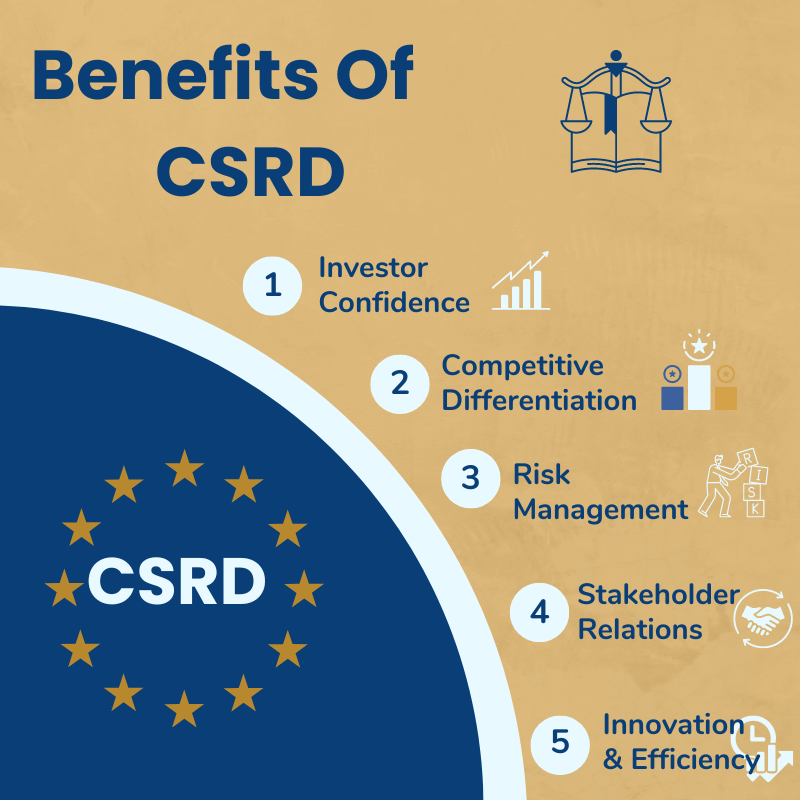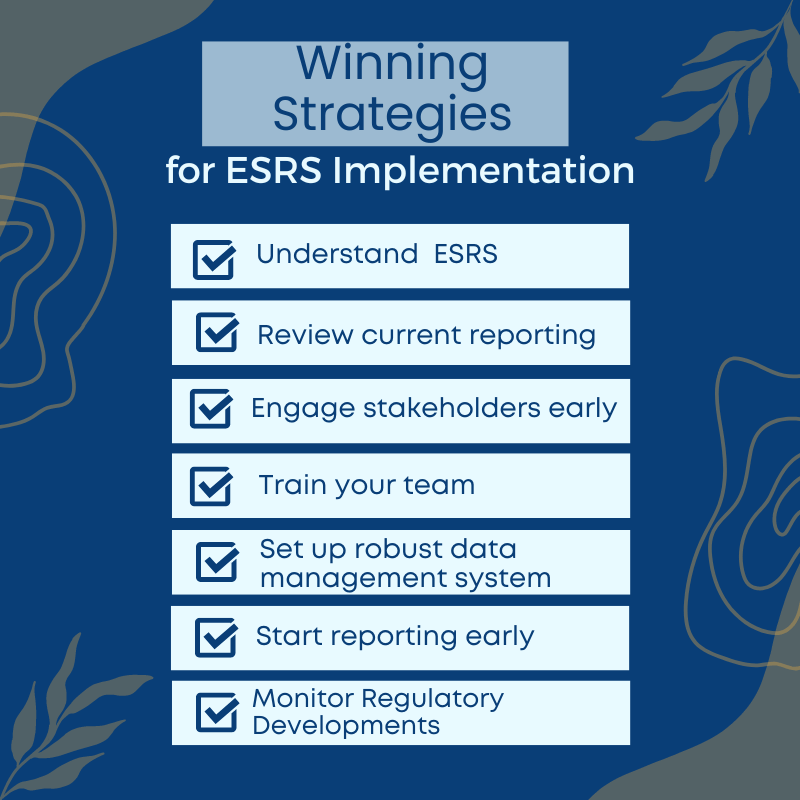Why was the CSRD adopted?
The CSRD, standing for Corporate Sustainability Reporting Directive, was born from the pressing need to address the sustainability challenges that the European Union grapples with. The ambitious European Green Deal targets the creation of the first climate-neutral continent by 2050, with the CSRD playing a critical role in realizing this vision. The new EU directive broadens the scope of non-financial reporting requirements for large companies, and listed companies including SMEs, enveloping aspects like climate-related risks and opportunities, social impact, environmental consequences, and corporate governance. The importance of sustainability risks and opportunities in determining the longevity of a company’s success is now recognized, which necessitates their clear communication to stakeholders. The CSRD is a significant step towards the creation of a standardized and comprehensive framework governing the reporting of sustainability matters by companies. The intended outcome is a facilitation of company comparisons, improved financial modelling accuracy, and boosted transparency for investors and stakeholders. The CSRD signifies tangible progress in implementing sustainable finance and non-financial reporting, in alignment with the broader sustainability goals of the EU. The directive encapsulates the escalating importance of sustainability in the realm of economic activity and the obligation businesses have towards ensuring their social and environmental impact is responsible.
What separates NFRD from CSRD?
Both the Non-Financial Reporting Directive (NFRD) and the Corporate Sustainability Reporting Directive (CSRD) represent pivotal regulations introduced by the European Union (EU). The NFRD, launched in 2018, influenced all large EU-based companies, intending to guide them towards transparent disclosure of material sustainability information, as well as social and environmental concerns. The newly rolled out CSRD serves as an evolution of the NFRD, refining disclosure requirements, which includes the alignment with the EU Taxonomy to assist companies in reporting sustainable economic activities. The fundamental distinction between the directives is that while the NFRD had more limited sope and required fewer disclosures, the CSRD extends to not only large companies, but also listed SMEs, and non-European copanies meeting certain criteria. The CSRD also expands the concept of sustainability reporting further and include a more comprehensive set of disclosure requirements. The intention behind both directives is to encourage corporate sustainability reporting and preserve the interests of diverse stakeholders by ensuring they have access to pertinent information regarding a company’s environmental and social impacts. This empowers companies to address stakeholder expectations and worries, such as mitigating carbon emissions and rectifying environmental damage. Adherence to the NFRD and CSRD is therefore a duty companies must fulfill towards a greener and more socially accountable world.
What are the pros and cons of the CSRD?
The Corporate Sustainability Reporting Directive (CSRD) is a recent legislation proposed by the European Union (EU) that seeks to harmonize existing sustainability reporting requirements for companies and boost the accountability and transparency of their sustainability efforts. The CSRD obliges companies to disclose Environmental, Social, and Governance (ESG) information, which will be integrated into their annual management report and must be audited by an independent third party.
The primary benefit of the CSRD is its ability to equip investors and stakeholders with the knowledge they need to make informed decisions about a company’s long-term sustainability and their contribution to a sustainable economy. Moreover, the legislation promotes increased transparency and accountability from companies regarding their sustainability efforts, fostering higher trust and confidence from investors and consumers.
Despite these benefits, the CSRD comes with potential drawbacks. A primary concern is the additional resources, both in terms of cost and time, required for companies to align with the new requirements and regulations. Furthermore, meeting these requirements may prove challenging for small and medium-sized enterprises (SMEs), potentially creating competitive disadvantages. Hence, the response of companies to the CSRD and its eventual impact on enhancing sustainability within the European business landscape remains to be seen.
Who benefit from the CSRD?
The CSRD is designed to elevate the level of sustainability in businesses by improving transparency and accountability in the reporting of sustainable economic activities. The CSRD, a part of the EU’s Green Deal initiative, promotes sustainable investments while discouraging greenwashing, a practice wherein companies make misleading claims about the sustainability of their products and services.
The new classification system introduced under the CSRD enables investors to better assess the sustainability impact of their investments, and consumers to make more informed decisions about products and services that align with their values. While everyone reaps the benefits of a more sustainable economy, as it assures long-term wellness for the planet and its dwellers, certain groups stand to gain more directly. For instance, companies that prioritize sustainability now have the ability to distinguish themselves from those that fail to comply with the CSRD. Investors who focus on sustainable investments will also benefit from the heightened transparency. Society at large stands to gain from a more sustainable future.
In summary, the CSRD is a win for all as it lays the groundwork for a more sustainable and transparent economic system.
If you prefer a summary video, you can watch this:
What are the advantages of sustainability reporting for companies?
Sustainability reporting has increasingly become a crucial aspect of a company’s operations in recent years. A sustainability report is a document that describes a company’s sustainability efforts, offering transparency to stakeholders about the business’s environmental and social impact.
A key advantage of such reporting is that it helps companies avoid accusations of greenwashing, where a company overstates its environmental credentials to garner consumer trust. Instead, sustainability reporting can demonstrate a company’s commitment to sustainability and help build trust with its stakeholders by providing evidence of their sustainable business practices. Additionally, sustainability reporting is becoming a mandate in many industries due to regulatory directives that require businesses to report on their environmental and social impact.
Sustainability reports can also assist companies in identifying areas for improvement, enabling them to establish goals and measure progress towards sustainable business practices. In conclusion, sustainability reporting is an important tool not only for demonstrating a company’s commitment to sustainability but also for improving its performance and ensuring transparency with stakeholders.
The Benefits of CSRD
So, what are the potential benefits of CSRD? Let’s explore how this directive can act as a catalyst for change and growth within businesses.

Enhanced Investor Confidence
With the increasing emphasis on ESG factors, investors are more focused than ever on the sustainability practices of the companies they invest in. CSRD reports are expected to provide valuable data to inform investment decisions, enhancing transparency and trust. It offers a detailed look into a company’s sustainability measures, thus promoting a sense of reliability and assurance among investors. This improved investor confidence can translate into tangible financial benefits, attracting more investment and potentially increasing the company’s market value.
Competitive Differentiation
In today’s business landscape, sustainability is no longer an option, but a necessity. By complying with CSRD, companies can establish themselves as leaders in sustainability, setting them apart from competitors. Furthermore, the CSRD compliance signals a company’s commitment to sustainable business practices, which can enhance its reputation, increase customer loyalty, and potentially lead to increased market share.
Improved Risk Management
ESG risks can have significant impacts on a company’s performance and reputation. By requiring companies to report on these risks, the CSRD encourages proactive risk management. It compels companies to scrutinize their operations for potential environmental, social, and governance risks, and develop mitigation strategies. In turn, this can reduce liabilities and help companies avoid costly incidents, penalties, or reputational damage.
Strengthened Stakeholder Relations
Transparency is crucial in fostering strong relationships with stakeholders, including customers, employees, suppliers, regulators, and the wider community. The CSRD, by promoting disclosure of ESG activities, enables businesses to engage stakeholders more effectively. By demonstrating commitment to social responsibility and sustainable practices, businesses can enhance stakeholder trust and loyalty, fostering a more positive brand image.
Innovation and Efficiency
The process of preparing a CSRD report can lead to valuable insights into a company’s operations, revealing opportunities for innovation and efficiency. It pushes businesses to evaluate their processes and value chain, uncovering areas where resources can be utilized better or waste reduced. In the long run, this can lead to cost savings, improved operational efficiency, and increased resilience in the face of environmental and market changes.
Conclusion
Embracing the CSRD is not merely about regulatory compliance. It’s an opportunity to reframe business models, drive sustainable innovation, and create enduring value. It’s about fostering transparency, promoting accountability, and enhancing resilience. It’s a powerful tool that companies can leverage to attract investment, differentiate themselves from competitors, manage risks, strengthen stakeholder relationships, and drive efficiency.
In a world where sustainability is no longer a buzzword but a business imperative, the CSRD offers a pathway to sustainable success. With its focus on disclosure and transparency, the CSRD is reshaping the corporate landscape, promoting sustainable business practices and, in turn, a more sustainable future. Understanding its potential benefits can help businesses turn a regulatory requirement into a strategic advantage.
Your Next Step on the CSRD Compliance Journey
Are you ready to spearhead your company’s sustainability journey and stand out from the crowd? The Corporate Sustainability Reporting Directive (CSRD) and European Sustainability Reporting Standards (ESRS) are not only coming but are here, and your next steps are critical.
Mastering the complexities of the CSRD and ESRS can seem like a daunting task. However, overcoming this challenge doesn’t just mean compliance with new laws – it’s an opportunity to show your commitment to a sustainable future, to gain a competitive edge, and to attract stakeholders who value responsibility.
We know it might be overwhelming, but you’re not alone in this journey. Imagine having all the necessary tools, knowledge, and support at your fingertips. That’s where The CSRD Compass steps in. We’re your ultimate guide to everything CSRD and ESRS, offering a rich collection of resources ranging from detailed guides and insightful articles to comprehensive courses and expert analysis. Navigating this new terrain of sustainability reporting has never been easier!
Don’t wait for tomorrow. The time to act is now. Embark on your sustainability reporting journey today, prepare your business for a sustainable future and make a real impact on our planet. Visit The CSRD Compass today, and let’s shape a greener future together!


